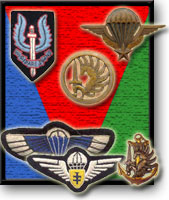First Special Service Force
The First Special Service Force (FSSF aka the Force) was a joint American-Canadian commando unit with separate combat and service echelons. It was activated on 20 July 1942, under Lt. Colonel Robert T. Frederick, and was based at Fort Harrison, Montana. The men (selected for their rugged, outdoor backgrounds) received the most igorous training schedule (under live fire) ever undertaken by an American Army unit. They became an elite body of soldiers.
The Force was assigned to Operation Plough. The plan was to parachute the unit into German-held Norway, knock out important hydroelectric plants, perform other acts of sabotage, and then fight their way to a neutral border. They trained for nine months for the Norway Operation, taking extensive courses in raider and commando tactics and receiving intense training as paratroopers, ski troops, mountain fighters, demolition experts, amphibious forces and hand-to-hand combat experts. Deemed impractical, the Norwegian operation was cancelled.
The Force’s first operation was the US landing on Kiska in the Aleutian Islands in August 1943. Though the lack of enemy troops (who had been evacuated earlier) provided a bloodless victory, it gave the Force some much needed field experience.
The Force was shipped to Italy in November 1943 where it fought with distinction for nearly a year. It first went into action at Monte La Difensa in Kesselring's Winter Line on 3 December. In this action they cleared a strategic German defensive position high atop a mountain surrounded by cliffs. The Force accomplished this in hours, where previous Divisions had tried and failed for weeks, suffering many casualties. Mountain fighting continued at places like Monte La Remetanea, Monte Sammucro, Radicosa, Monte Majo, Monte Vischiataro and after a brief period of rest, the Anzio beachhead. It would be at Anzio that the Force's mystique would grow. Named "Die Schwartze Teufeln” (The Black Devils) by the Germans, their ferocious nightime fighting ability would become legendary.
At Anzio, although at only half strength, they held at least ¼ of the entire beachhead until the final breakout for Rome in late spring of 1944. After being the first unit into Rome, the Force led the invasion of Southern France with the U.S. 7th Army and fought eastward until December 1944. It was at this point that it was decided that the need for a smaller, commando style, unit was deemed unnecessary and the Force was disbanded. The Canadians were returned to the UK as the 2nd Canadian Parachute Battalion, but this formation was short lived, the majority of the Canadians going to the 1st Canadian Parachute Battalion as replacements.
Some of the US elements were incorporated into the 474 th Infantry regiment.


